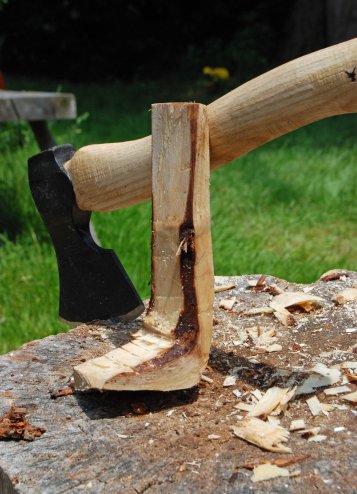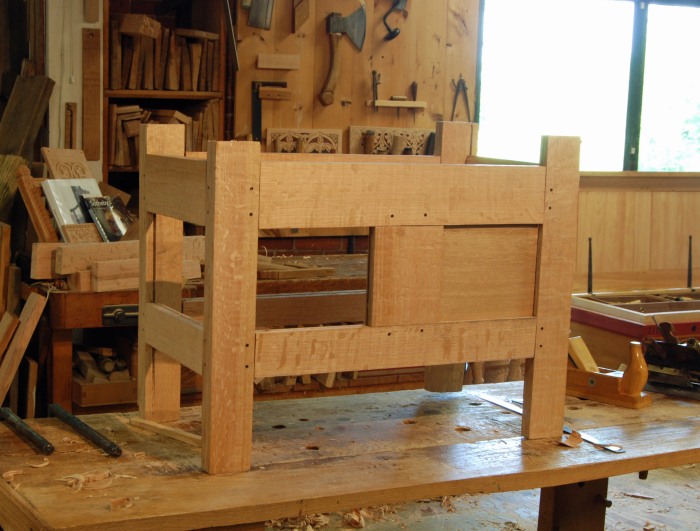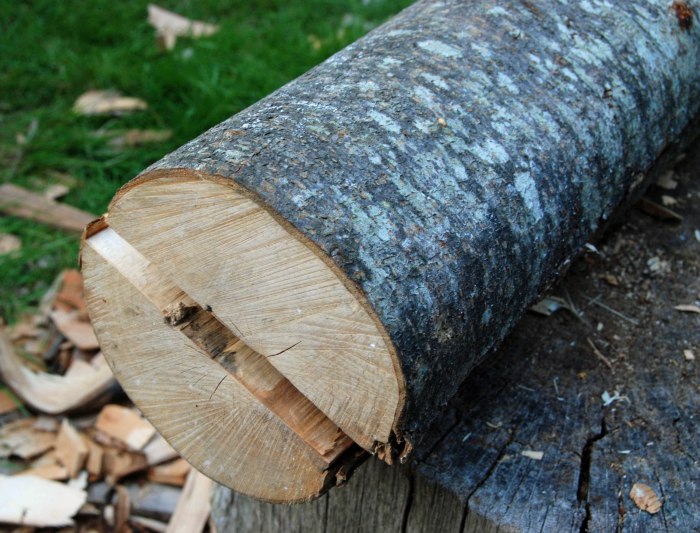A few very quick things. I do make furniture, believe it or not. Too much lately in fact, the shop is jammed. I see daylight at the end of August. Here is a small joined chest that I am making as a test-case for a few upcoming gigs. More on that later…it’s about 20″ high, x 30″ wide. It is a mixture of riven & sawn oak, and I’ll use some sawn pine for the bottom and rear panel. Just like the full-blown joined chests, https://pfollansbee.wordpress.com/2012/10/20/joined-chest-dvd-now-available/ all the same steps, just smaller scale. Like for a workshop sometime?
The other day I was out walking in the park (like Muddy Waters, I guess) and saw an uprooted tree cluster. The trees were gone, and the roots hauled up, soon to be chipped. I grabbed some real curved pieces. I thought it was maple, but it seems closer to ring-porous. but not quite…
anyway, the next spoon is brought to us by the letter J. Boy, are roots wet!

Here are two views as I worked this one up. I can’t shoot spoon work like I can joinery. The setup is trickier. I had Daniel shoot some last week, I have to load those and sort them.


While on the subject of unknown spoon woods, I thought I’d take the easy way out & ask you folks what wood this is. It ended up in my pile, and it’s excellent for spoons. Tough, but not as hard as the cherry I often use. very white, no heartwood. I never saw the leaves, so only have this stuff to look at. I’ll take it to the shop and cut the end grain cleanly to see its structure.
Just finished this version of the dragon box, or is it a serpent box? red oak, white pine. It’s about 23 1/2″ x 14 1/2″ x 7″.







beautiful as always !
I once sawed a storm felled walnut tree. The root ball came out of the ground and I left it once I sawed off the “good part”. I have felt dumb ever sense.
Nice spoons. that is really white wood. I assume it is not holly or you would know it.
Hi Bob, – yes, it’s not holly. I should have said what I know it ain’t. Not maple, holly, apple. not any birch that I am aware of, hmm. Can;t think of others. It’s harder & heavier than white birch.
Peter, it looks like it is a fast growing tree. Did it have a particular scent? Was it stringy or smooth carving? At first glance of the bark, I would have picked some form of Poplar and I know there are many. Too fast growing and probably to soft to be Beech or Hornbeam. I am leaning towards some form of Poplar what about white or Weeping Willow?
Bark looks like a Beech….
I expect you would have known the spicy mint scent of Black Birch if that were it, as I might have guessed from the pictures.
I’m leaning to black birch, but it’s not something I’m familiar with. This is heavier and harder than paper or white birch.
Black and Yellow Birch would have a Red Heart and smell like Wintergreen.
As always the work looks top notch,But a hatchet stuck in a stump!? Could be sassafras.
Hatchet was just to prop the spoon up for photo. Sassafrass is ring-porous I believe. this isn’t.
I’ll toss in my guess for a young sycamore…
After sleeping on it and looking at the darker pith, It also could be a young Silver maple.
I would guess serviceberry (genus Amelanchier) – – occasionally they get that big in Wisconsin. But you say it’s not as hard as cherry, which wouldn’t be right. Does laurel cherry (aka cherry laurel) grow that far north?
it’s my favorite box.
Ahh., this one’s for a client. Now if the first one ever goes missing…
Hi Peter…not to be a pain, but is one of those legs on upside down? I cringe at the thought of having to un-join a piece like that.
Me thinks all the legs will be trimmed later.
I’d like to vote for the log being this:
http://en.wikipedia.org/wiki/Carpinus_caroliniana
I’m in agreement with R. Lindh, I think it might be beech. I recently made some spoons out of beech and it was a bit heavy but dried out nicely and it has a great tonal quality to it. It was a fast growing limb and it was really white wood. The picture of the limb looks like what I had.
It all depends on how heavy the wood was. The Bark is a little too black to be out PA Beech and ut us far too smooth to be any of the Birches.
It looks like a young maple or a sucker branch of maple.Probablysilver. Maple under 6 or 8″ is often smooth and mottled like this before it becomes shaggy loose.
it looks like you might have a piece of immature yellow poplar. very fast growing and straight, light creamy colored wood, sapwood is almost indistinguishable from heartwood. except for the hard part, poplar is relatively soft.
i have a lot of beech, and i can usually identify it easily. this doesn’t look like beech, not the bark nor the wood. http://www.wood-database.com/lumber-identification/hardwoods/american-beech/
Hi Peter. I love the frunky spoons. The more crooked the better.. (for those hard to reach spaces in the stew pot)
Are you still looking for a handle for the Ronnqvist?
I don’t see a problem with your spoon photos however if you want to spend some time on it I’d suggest adjust the angle of the spoon to the light or the light to the spoon to throw strong shadows in the hollows, and then introduce a 2nd dimmer light source to fill the shadow without wiping it out. That source could be the camera flash toned down, or in your case a pale board or bowl to reflect ambient light into the shadows Picking out the rim with light from slightly behind could be fun to play with.
Googel the late “Brian Brake” and “Te Maori” TOGETHER for some carved images that use multiple light sources if you’re not sure what I mean.
day late and dollar short here…. Roots frequently have a vastly different texture from the trunk.